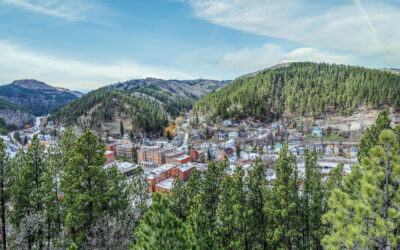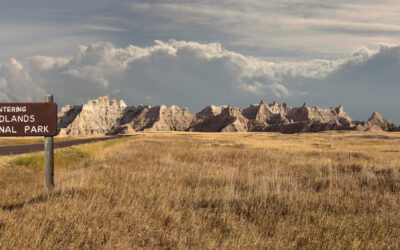Whispers from the Past: The Indigenous Legacy
The Lakota and the Sacred Paha Sapa
The Black Hills, or Paha Sapa to the Lakota, hold a profound significance that transcends their geographical prominence. Revered as the heart of everything that is, the sacred Paha Sapa has been the spiritual and cultural epicenter for the Lakota people for centuries. The hills resonate with the history of the Lakota, whose traditions and beliefs are deeply interwoven with the land.
The Lakota’s connection to the Black Hills is evident in their stewardship of the land. This bond is reflected in the way they managed the bison herds, which were crucial to their way of life, and in their deep understanding of the hills’ ecology. The Black Hills served not only as a source of sustenance but also as a place for spiritual reflection and ceremony.
Visitors to Western South Dakota today can witness the legacy of the Lakota through the region’s iconic landmarks and cultural experiences. From the awe-inspiring Mount Rushmore to the rugged beauty of Badlands National Park, the area invites exploration and discovery. Historic towns and attractions offer a glimpse into the rich tapestry of human endeavor that has shaped the hills over time.
Archaeological Wonders: Artifacts and Petroglyphs
The Black Hills of South Dakota, known to the Lakota as Paha Sapa, are not only a region of breathtaking landscapes but also a canvas of human history etched in stone. The area’s archaeological sites offer a glimpse into the lives of the indigenous peoples who have called these lands home for thousands of years. Artifacts and petroglyphs scattered throughout the hills tell stories of culture, spirituality, and survival.
These ancient relics range from tools and weapons to intricate carvings on rock faces. The petroglyphs, in particular, are a testament to the rich narrative traditions of the Lakota and other tribes. They serve as a visual record of their beliefs, with symbols and figures representing aspects of their cosmology and daily life. Visitors to the Black Hills can explore several sites where these historical treasures are preserved and interpreted.
To truly appreciate the archaeological significance of the Black Hills, consider the following key locations and their contributions to our understanding of the region’s past:
- Bear Butte: A sacred site with petroglyphs that reveal the spiritual practices of the Plains tribes.
- Wind Cave: Known for its boxwork formations and the cultural importance it holds in Native American mythology.
- Black Hills Cave: Where artifacts provide evidence of early human habitation and use of natural resources.
South Dakota offers diverse attractions, museums, entertainment venues, and historic sites. Explore arts, entertainment, parks, regions, and Mount Rushmore in this vibrant state.
The Fort Laramie Treaty of 1868: Promises and Betrayals
The Fort Laramie Treaty of 1868 was a pivotal moment in the history of the Black Hills, marking a solemn promise of peace and territorial sovereignty to the Lakota people. The treaty recognized the Black Hills as sacred land, exclusively belonging to the indigenous tribes. However, the discovery of gold led to a surge of settlers, and the U.S. government soon reneged on its commitments, igniting conflicts that would mar the landscape of trust.
The treaty’s aftermath saw a series of legal battles and land claims that have echoed through the centuries. Here’s a brief overview of the key points:
- The treaty established the Great Sioux Reservation, including the Black Hills, as off-limits to white settlement.
- The 1874 discovery of gold by Custer’s expedition violated the treaty, prompting an influx of miners.
- The U.S. government’s attempt to purchase the Black Hills was rejected by the Lakota.
- The 1877 Act of Congress forcibly seized the land, leading to the Black Hills War.
Today, the legacy of the Fort Laramie Treaty is a complex tapestry of cultural significance and legal contention. The Crazy Horse Memorial, while not directly related to the treaty, is a modern embodiment of the ongoing struggle for recognition and respect of Native American rights and history. It faces controversies but stands as a monumental tribute to Crazy Horse’s legacy.
A Tapestry of Nature and Human Endeavor
Gold Rush and the Transformation of the Black Hills
The discovery of gold in 1874 by the Custer Expedition ignited a surge of prospectors into the Black Hills, forever altering the landscape and the lives of its indigenous inhabitants. This event marked the beginning of the Gold Rush, a pivotal moment that transformed the Black Hills from a sacred land into a bustling hub of mining and economic activity.
The influx of settlers led to the establishment of towns such as Deadwood, which quickly gained notoriety for lawlessness and the promise of wealth. The Gold Rush also prompted the construction of railroads, facilitating the transport of gold and other goods, and further integrating the region into the wider American economy.
Despite the initial boom, the Gold Rush’s legacy is complex, with long-lasting impacts on the environment and the original custodians of the land. Today, the Black Hills in South Dakota offer a rich history, diverse economy, and major tourist attractions like Mount Rushmore, attracting visitors with unique experiences and natural beauty.
Wildlife of the Black Hills: A Delicate Balance
The Black Hills of South Dakota are not only a monument to natural beauty but also a sanctuary for diverse wildlife. The region’s fauna ranges from large mammals like the bison and elk to smaller species such as the prairie dog and the black-footed ferret. The delicate balance of this ecosystem is maintained through careful wildlife management and conservation efforts.
Recent data indicates a concerning decline in deer numbers in southeastern South Dakota, prompting proposed changes to hunting licenses. This is a testament to the ongoing challenges in wildlife preservation. The South Dakota Game, Fish, and Parks Commission is actively engaged in ensuring the health and sustainability of these animal populations.
Here’s a snapshot of the wildlife management initiatives in the Black Hills:
- Monitoring and adjusting deer hunting licenses to reflect population changes
- Habitat restoration projects inspired by natural processes
- Partnerships with state agencies for species recovery efforts
As we explore South Dakota’s diverse attractions, including the iconic Mount Rushmore, it’s crucial to recognize the importance of these conservation measures. They not only protect the wildlife but also ensure that future generations can enjoy the natural beauty and adventure that the Black Hills offer.
Modern Conservation Efforts: Preserving the Hills
The Black Hills of South Dakota, known for their majestic beauty and rich history, are also a testament to the ongoing efforts in conservation. Modern conservation initiatives are crucial in maintaining the delicate balance between human activities and the natural environment. These efforts encompass a range of strategies aimed at preserving the unique biodiversity and cultural heritage of the region.
One of the key approaches to conservation in the Black Hills is habitat restoration. Inspired by nature’s own engineers, such as beavers, projects are underway to rejuvenate areas affected by wildfires and other disturbances. This not only aids in the recovery of the land but also ensures the survival of various species that call these hills home.
Collaborative efforts are at the heart of conservation in South Dakota. A multitude of partnerships between state agencies, local communities, and conservation groups work together to implement projects on working landscapes. These projects often include:
- Streambank stabilization
- Restoration of aquatic habitats
- Planting of native grasses and forbs
- Wetland restoration and enhancement
Moreover, financial assistance and federal programs like the Farm Bill Conservation Programs play a pivotal role in supporting private land conservation. These initiatives help landowners integrate sustainable practices into their land management, ensuring that conservation efforts are widespread and effective.
As visitors explore the diverse attractions of South Dakota, from the iconic Mount Rushmore to the serene Adams Homestead, it’s essential to recognize the conservation efforts that make these experiences possible. The commitment to preserving the Black Hills ensures that future generations can continue to enjoy and learn from this remarkable landscape.






